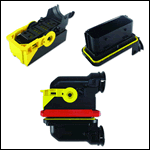Embedded Optical Engines Find Their Niche
Demand for higher data rates, panel density, and practical channel lengths with acceptable signal integrity have put pressure on copper connectivity to deliver the most practical solution. Embedded optical transceiver technology emerges to address this need.
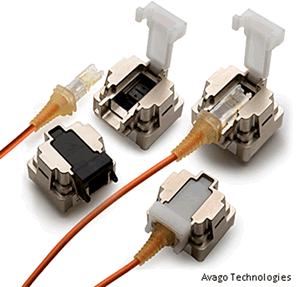 Copper circuits still rule the high-speed electronic world, but optical alternatives continue to chip away at that dominance in niche applications. While the technical advantages of optical interconnects have been recognized for years, adoption in volume-production products has been hampered by a combination of increased cost, perceived lack of durability, increased power consumption, and reluctance to change from a well known technology. Demand for higher data rates, panel density, and practical channel lengths with acceptable signal integrity has put pressure on copper connectivity to deliver the most practical solution.
Copper circuits still rule the high-speed electronic world, but optical alternatives continue to chip away at that dominance in niche applications. While the technical advantages of optical interconnects have been recognized for years, adoption in volume-production products has been hampered by a combination of increased cost, perceived lack of durability, increased power consumption, and reluctance to change from a well known technology. Demand for higher data rates, panel density, and practical channel lengths with acceptable signal integrity has put pressure on copper connectivity to deliver the most practical solution.
An emerging technology designed to address this problem is the mid-board or embedded optical transceiver. Rather than converting high-speed electrical signals at the I/O panel using pluggable interfaces such as SFP or QSFP, a mid-board transceiver moves the electro-optical conversion process very close to the signal source such as a processor, ASIC, or serdes chip. Taking high-speed signals off of the PCB offers several advantages:
- PCB design becomes less complex as hand routing is often required to isolate high-speed lines on the board. Board costs may be reduced with lower layer counts and use of less costly laminates.
- Potential electromagnetic interference (EMI) issues are reduced as optic links generate no EMI nor are susceptible to external noise.
- Much greater I/O port density offers improved connectivity. Less front-panel space consumed per I/O connector allows space for more connectors and cooling vent areas.
- Optic links enable longer channels with reduced signal degradation.
- It provides higher bandwidth capacity in smaller and lighter fiber links.
The I/O capacity of these embedded transceivers is impressive. With up to 12 full duplex channels running at 25Gb/s, system designers are able to provide up to 300Gb/s connectivity using minimal panel space.
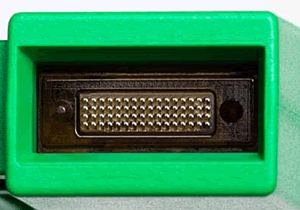 Although most current applications are focused on front-panel I/O, fibers coming from mid-board transceivers can also be directed to a blind-mate optical interface at the backplane. The new MXC optical connector, for instance, can contain up to 64 fibers, each running at 25Gb/s to deliver a total of 800Gb/s full duplex I/O in a connector roughly 10mm X 5mm. Mating fiber cables can extend to external equipment or connect to an optical shuffle to provide linkage among daughtercards in the rack.
Although most current applications are focused on front-panel I/O, fibers coming from mid-board transceivers can also be directed to a blind-mate optical interface at the backplane. The new MXC optical connector, for instance, can contain up to 64 fibers, each running at 25Gb/s to deliver a total of 800Gb/s full duplex I/O in a connector roughly 10mm X 5mm. Mating fiber cables can extend to external equipment or connect to an optical shuffle to provide linkage among daughtercards in the rack.
Occupying as little as one square inch each, multiple mid-board transceivers can be tiled on the board to create immense I/O density.
Avago Technologies was one of the first to introduce mid-board optical modules. They currently offer Micro and MiniPOD transmitter and receiver modules with up to 12 channels running at 10Gb/s per channel. These modules mate with the Prizm connector for coupling to 12-fiber ribbon cable. Modules are attached to the PCB using the FCI MEG-Array connector.
Several leading connector manufacturers, including FCI Electronics, Molex, Samtec, and TE connectivity, have invested extensive resources to develop mid-board optical transceivers. Amphenol TCS is also developing a mid-board optical transceiver that will be announced within three to six months.
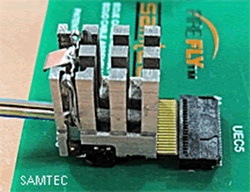 Samtec introduced its Firefly Flyover optical module several years ago, which features both a copper and optic interface using a common PCB header. Its latest product supports 12-channel, 28Gb/s performance at lengths to 100 meters.
Samtec introduced its Firefly Flyover optical module several years ago, which features both a copper and optic interface using a common PCB header. Its latest product supports 12-channel, 28Gb/s performance at lengths to 100 meters.
More recently introduced modules integrate transmit and receive functions into a single device. Molex QuatroScale mid-board transceivers feature eight duplex channels operating at 25Gb/s each. Pigtailed fibers can be terminated at the backplane or front panel.
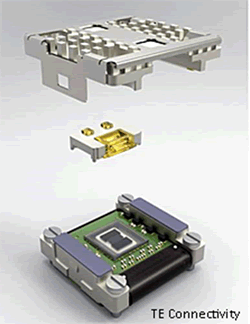
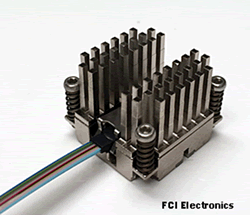
TE CoolBit and FCI LEAP transceivers deliver 12 channels at 25Gb/s per channel while occupying a total of one square inch of board space. A standard 2X12 MT interface provides optic connectivity to both modules. They also feature integrated heat sink covers and achieve PCB connectivity via BGA/LGA sockets.
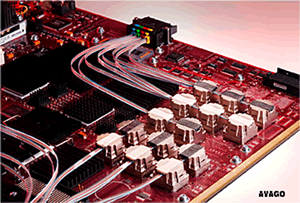 A variety of systems have slowly started to take advantage of embedded optical transceivers, including switches and core routers, primarily in large data centers and high-performance computing equipment such as supercomputers.
A variety of systems have slowly started to take advantage of embedded optical transceivers, including switches and core routers, primarily in large data centers and high-performance computing equipment such as supercomputers.
The Arista 7500 is a high-performance data switch that offers an optional line card that utilizes embedded MiniPod modules linked to 12 MPO ports on the I/O face plate. The MPO interfaces consume much less space and power than 12 SFP pluggable connectors.
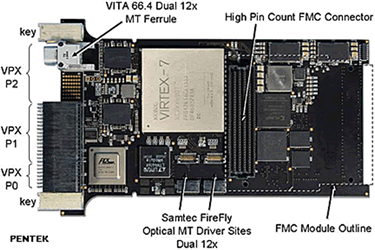 Embedded computer boards from Pentek utilize Firefly optical modules that interface with VITA 66 backplane connectors.
Embedded computer boards from Pentek utilize Firefly optical modules that interface with VITA 66 backplane connectors.
Although 25Gb/s links can be economically implemented in copper, designers of advanced systems want a clear migration path to 50Gb/s and beyond and do not want severe restrictions on channel length.
Optical transceivers will likely encounter headwinds that will hinder wide adoption. Current products on the market are proprietary with no announced second sources. PBC footprints, power consumption, plugability, and physical profiles differ among products.
Relatively high prices will remain an issue. At some point in time, establishment of multi-source agreements (MSAs) among module manufacturers will alleviate this problem. While embedded optical transceivers are not likely to enjoy the rapid acceptance of active optical cables, new applications will become less niche-oriented over time.
The path to broad acceptance of optical connectivity continues to be delayed. Utilization of PAM 4 signaling in emerging 50Gb applications will take some of the pressure off copper links, which struggle using NRZ signaling. Mid-board optical transceivers open the door to extreme I/O data rates and signal density in select applications today and pave the way to achieving performance objectives in equipment slated for the next generation and beyond.
- Optics Outpace Copper at OFC 2024 - April 16, 2024
- Digital Lighting Enhances your Theatrical Experience - March 5, 2024
- DesignCon 2024 in Review - February 13, 2024


